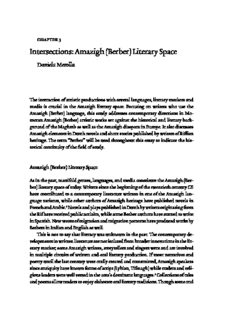
Intersections:Amazigh(Berber)LiterarySpace PDF
Preview Intersections:Amazigh(Berber)LiterarySpace
chapter3 Intersections: Amazigh (Berber) Literary Space DanielaMerolla Theinteractionofartisticproductionswithseverallanguages,literarymarketsand media is crucial in the Amazigh literary space. Focusing on writers who use the Amazigh(Berber)language,thisstudyaddressescontemporarydirectionsinMo- roccanAmazigh(Berber)artisticworkssetagainstthehistoricalandliteraryback- groundoftheMaghrebaswellastheAmazighdiasporainEurope.Italsodiscusses AmazighelementsinDutchnovelsandshortstoriespublishedbywritersofRiffian heritage.Theterm“Berber”willbeusedthroughoutthisessaytoindicatethehis- toricalcontinuityofthefieldofstudy. Amazigh(Berber)LiterarySpace Asinthepast,manifoldgenres,languages,andmediaconstitutetheAmazigh(Ber- ber)literaryspaceoftoday.WriterssincethebeginningofthetwentiethcenturyCE havecontributedtoacontemporaryliteraturewritteninoneoftheAmazighlan- guagevariants,whileotherauthorsofAmazighheritagehavepublishednovelsin FrenchandArabic.1NovelsandplayspublishedinDutchbywritersoriginatingfrom theRifhavereceivedpublicacclaim,whilesomeBerberauthorshavestartedtowrite inSpanish.Newwavesofmigrationandmigrationpatternshaveproducedworksby BerbersinItalianandEnglishaswell. Thisisnottosaythatliteracywasunknowninthepast.Thecontemporaryde- velopmentsinwrittenliteraturearenotisolatedfrombroaderinnovationsinthelit- erarymarket;someAmazighwriters,storytellersandsingerswereandareinvolved inmultiplecircuitsofwrittenandoralliteraryproduction.Ifmostnarrativesand poetryuntilthelastcenturywereorallycreatedandtransmitted,Amazighspeakers sinceantiquityhaveknownformsofscript(Lybian,Tifinagh)whiletradersandreli- giousleaderswerewellversedinthearea’sdominantlanguages.2Collectionsoftales andpoemsallowreaderstoenjoyelaborateoralliterarytraditions.Thoughsomeoral 48 | merolla genresseemtodisappearalongwiththeircontextsofproduction,newformshave alsoarisen.Increasingly,theoverwhelminglyvariedandenormouslypopulargenre of“modernsongs”incorporates“classical”musicalstyleswithinspirationandin- strumentsfromaroundtheworld.Forexample,thesongsofHindiZahra,whosings inEnglish,andChleuhBerberincorporateChleuhsoundswithblues,jazz,Ameri- canfolk,Egyptianmusic,andtheinfluenceofAfricansingerssuchasAliFarkaTouré and Youssou N’Dour.3 Another example is the music of the Tuareg band Tinari- wenwhosemembersplayteherdent(lute),imzad(violin),tinde(drum)andelectric guitar. Morgan4 argues that they merge the Tuareg style of assouf (“solitude” or “nostalgia”)withinfluencesfromKabyleBerbercontemporarysongs,Malianblues, AlgerianurbanraïandMoroccanchaabi,pop,rockandIndianmusic.5 Anotherexamplemaybeseenintherevitalizationoffolktalesinfamilysettings andschoolsthroughfilms,novels,children’sbooks,andcartoons.Notonlyarefolk- talesdocumentedinpastcollections,buttheyalsorepresentastillvigorousoral heritagerespondingtothenewcontextsofschooleducationandexposuretovar- iousmedia.6Thankstointernationalattention,storytellersagainnarratefolktales andperformcomicpiecesintownplazas.Forexample,Djamaael-FnaSquareinMar- rakesh,wherestorytellersgather,wasaddedtotheUNESCOWorldHeritageListin 2001,whileresearchers,journalists,photographersandtouragencieshavedrawnat- tentiontoArabicandBerberMoroccanstorytellinginpublicsquaresandmarkets.7 Told,sung,written,video-recorded,andspreadonline,8Amazighoralliteratureis takingonanewlife. Thenotionof“literaryspace”canhelpustounderstandlong-termaswellas morerecentdevelopments,whichincludemultilingual,multimediaproductions thatintersectandinteractwithliteraturesproducedinoneofthevernacularforms ofAmazigh(theBerberlanguage).9Acrosslanguagesofcreationandvariationsinin- dividualpositions,weseenumerousoralandwrittenworksmarkedbytheirauthors’ familylanguageandbyscenesandcharacters(partially)setinAmazighenviron- ments.ThenationalistcritiqueinMoroccoandAlgeria10andthedebateoverthe literaryuseoflanguagesotherthantheauthor’s“mothertongue”11notwithstand- ing,weseethatthenewpoliticalandintellectualclimateoftheMaghrebisleading toacceptanceofthemultilingualismthathasresultedfromlong-termprocesses ofexpansionandmigration.Byrecognizingthecreativeprocessthathasresulted frominteractionwithotherliteraturesand“literaryspaces,”theumbrellanotionof “Amazigh(Berber)literaryspace”transcendsthedistinctionbetween“Amazighlit- erature”–i.e.createdinoneoftheAmazighvernaculars–andliteraryworksinother languages. intersections:amazigh(berber)literaryspace | 49 Tamazigh/Amazigh/ImazighenintheMaghreb SomenotesonthedenominationandgeographicalspreadoftheAmazigh(Berber) languagemaybeusefulatthispoint.Sincethe1990s,theterm“Amazigh”(orAma- zighlanguage)hasseenwidespreaduse.12Ithasgraduallyreplaced“Berber”indaily use; and it is accepted in academic discourse.13 Amazigh is used in the names of theinstitutescreatedtostudytheAmazighlanguageandcultureinAlgeria(Haut Commissariatàl’Amazighité,1995)andinMorocco(InstituteRoyaldelaCulture Amazighe,2001).OthertermssuchasTarifit,Tachelhiyt,TakbaylitandTamashekde- scribesomeofthelanguagevariationsspokenlocallyfromMoroccototheEgyptian oasisofSiwa,alongtheLibyanborder,andfromtheMediterraneancoasttoMaurita- nia,Mali,Niger,BurkinaFasoandnorthernNigeria.InMoroccopeoplespeakTarifit intheRifmountains,TamazightintheMiddleAtlas,andTachelhiyt(orChleuh)fur- thersouthintheSoussregion.Amazighpeopleareestimatedtonumberbetween 12and25million,whichmakesAmazighthesecondlanguageoftheMaghrebaf- terArabic.14Asaconsequenceofmigration,thereareAmazigh(Berber)communities inFrance,Belgium,Spain,Italy,theNetherlands,CanadaandtheUnitedStates.An estimatedtwo-thirdsofMoroccanimmigrantsintheNetherlandsspeakTarifitor comefromaBerber-speakingregion.15 WecanspeakofrelatedBerber“languages”onaccountofthescatterednatureof AmazighlinguisticcommunitiesintheMaghreb,thepeculiaritiesoflocalvariants, andbecauseonlyafewspeakersinthepastwereconsciousofthelinguisticunityof Amazigh.Atthesametime,scholarsusethetermBerber“language”todenoteits unityatthemeta-linguisticlevelandtoindicateextendedinter-comprehension.16 Today,thetermsAmazighandImazighenindicateanewawarenessamongAmazigh speakersoftheirlinguisticunityandculturalspecificity. ThepresentpositionoftheAmazighlanguageintheMaghrebvarieswidely. ThoughtheirlanguageisrecognizedasanationallanguageinMaliandNiger,the oncenomadicTuaregshavebornethebruntofthecreationofmodernnation-states andtheirinsurmountableborders.17The2012Tuareg-ledrebellionanddeclaration oftheindependentstateofAzawadinNorthMaliarelinkedtolong-standingsocio- economicmarginalization.18InKadafi’sLibya,therewasnoroomforlanguagemi- norities, and the current situation remains far from clear.19 More open attitudes haveprevailedinMoroccoandAlgeria,whereacademicinstituteshavebeenfounded committedtothestudyofAmazighandAmazighcoursesofstudyhavebeenopenat majoruniversities.InMorocco,thepilotprojectsofalphabetizationinAmazighhave beenlaunchedbytheMoroccanRoyalInstituteforAmazighity,andtheAmazigh 50 | merolla languagegainedofficialstatusinthenewMoroccanconstitutionof2011.Never- theless,Amazighisnotyetfullyintegratedintomasseducation,andcontradictory policiesaffectgovernmentrecognitionofmultilingualism.20Recentdemonstrations intheMoroccanRifinfavorofeconomic,democraticandlanguagerightshavebeen metbymilitaryforce.21Althoughthedemonstrationswerepartofabroadernational movementfordemocratization,theyalsorevealedtheenduringdifficultiesexperi- encedbyregionalminoritieswithincentralizedstates. AmazighLiterarySpaceinMoroccoandtheNetherlands: NovelsandShortStories ReferencestoAmazighlanguagesandcommunitiesappearintheFrenchandArabic worksofrenownedMoroccanwriterssuchasMohamedKhair-Eddine,Mohamed ChoukriandAhmedToufiq.22MostknownforitsChleuhsettingisKhair-Eddine’s Légendeetvied’Agoun’chich.23 In the first part of this novel, the narrator discovers anddescribesanimpoverishedregionanditsinhabitantswhoseminoritycultureis threatenedbycolonialandpost-colonialeconomicandpoliticalsystems.24Thenar- rator’sdeepattachmenttotheChleuhlanguageandlandtakesforminanarrative thatreconstructsaforgottenpastfromtheperspectiveofaChleuhoutlawvillager. Therecreationoftalesandmythsinapoeticandoneiricstylequestionsthehomog- enizingandmanipulativevisionofculturalidentitypromotedbycentralizedpower andpolitics.25Theinitialnarrator’svoicerecollectslong-termcontinuityand“métis- sage”inAfrica,whilethenarrativeismarkedbyviolence,localandinternational conflicts,andlossofpersonalandsocialidentity.26 ThetalesofstorytellerandpainterMohamedMrabetpresentaparticularform oforal-writteninteractionandtakeonaninternational,multilingual,andurban forminPaulBowles’Englishtranslationand“recreation”.27Mrabet’smemoriesof theRifandhisattachmenttohisheritagearenarratedinthefirstchapterofhisau- tobiographicalworkwithEricValentin.28Morerecently,wefindelementsofKhair- Eddine’s oneiric approach in Mohamed Nadrani’s visual representation of social andhistoricalthemesinthecartoons“TheSarcophagusoftheComplex:Enforced Disappearances,”29 on political repression in Morocco under King Hassan II, and “EmirAbdelkrim,”30ontheRepublicoftheRif,claimingindependencefromSpain andtheMoroccanSultanin1921. AnumberofauthorsfromtheRifhaveachievedpublicandcriticalacclaimfor theirworksinDutch,includingAbdelkaderBenali,KhalidBoudou,SaidElHaji, intersections:amazigh(berber)literaryspace | 51 andMustafaStitou.BenalireceivedmajorliteraryawardsincludingtheGeertjan LubberhuizenAwardin1997,theLibrisPrizein2003,andtheBestForeignNovel in 1999 for the French translation of Bruiloftaanzee(WeddingbytheSea).31 Khalid BoudouwontheGoudenEzelsoorPrizein2002forHetschnitzelparadijs(TheSchnitzel Paradise),32whileMustafaStitoureceivedtheprestigiousVSBPoëzieprijsin2004for hispoemsVarkensrozeansichten(PinkPigsPostcards).33 ThewrittenproductioninAmazighhasgrowninrecentyearsthankstoChleuh andRiffianwriters.Althoughacademicinstitutionsdonotyetconsistentlysupport them,culturalassociationsacrosstheterritoryhavesupportedthepublicationof poemsandnovelsinAmazigh.34Twooftheoldestassociations,AMREC(Association MarocainedeRecherchesetÉchangesCulturels)andANCAP–Tamaynut(Associ- ationNouvellepourlaCultureetlesArtsPopulaires–TheNewOne),aswellas theAgadirSummerUniversity(AUEA),haveplayedkeyrolesinorganizingcultural meetingsforartists,activists,andscholarstodiscusslinguisticandliterarythemes. Since the 1970s, both AMREC and Tamaynut have published periodicals such as Amud(Seeds),Anaruz(Hope),Arraten(Documents),Tamunt(Togetherness),andTasa- fut(Torch).35Nevertheless,contemporarywrittenliteratureinvolvesacuteproblems ofmarketinggiventhesizeofthereadingpublic.Whereastheaterandstand-upco- mediansareabletobridgethecommunicationgapandattractlargeraudiences,36 Amazighnovelsandshortstoriesareoftenself-financedandscatteredacrossthe smallorephemeralperiodicalsofculturalassociations. Chleuh ThefirstcontemporarynovelwritteninChleuhwasMohammedAkunad’sTawargit dimik(ADreamandaLittleMore)publishedin2002.37Itaddressesa“classical”dilemma ofIslamicpreachingintheChleuharea:theneedtousethelanguageofthevillagers tocommunicatereligiousideasandvalues.38Butunforeseenconsequencesexplode whentheclericSiBrahimbeginstopreachinChleuh.Thevillagerswanthimto speakaboutgovernmentland-grabbingandcorruption.Understandingthesermon, womendonotrecognizethemselvesinthefeminineimagesderivedfromclassical textsandaskhimtopreachabouttheiractuallivesandpresentneeds.SiBrahim, underpressurefrompoliticalandreligiousauthorities,facesanewdilemma:give uphisinitiativeandpreachinArabicorabandonhispositionasfqihofthevillage.39 Byfocusingonindividualexperienceandavoidingdidacticdiscussionsoflanguage rights,thenoveljoinsastreamofMaghrebianworksthatexploretheruralworld.In 52 | merolla contrasttotheworksofKhair-EddineandAhmedToufiq,Tawargitdimikfocuseson thecontemporarytimeandworld. BeforeAkunad,MohamedMoustaoui,HassanIdBelqasmandAliSedki-Azayku and others had published collections of poems in Chleuh in the 1970s, while Ali MimounEssafipublishedthefirstChleuhplayinthe1980s.40Accordingtoseveral membersofthewriters’associationTirra(Writing),41therearediscerniblediffer- encesbetweenolderandyoungergenerationsofwriters.Earlierauthors,whousually beganwritinginArabicandlaterswitchedtoChleuh,wereinfluencedbyChleuh manuscriptsandtraditionalpoetryandrhythms.Youngergenerationstendtowrite in“standard”Amazigh,ofteninLatinorinTifinaghcharacters,andmakeuseofne- ologismsaswellastheotherAmazighlanguagevariantsofMoroccoandAlgeria.As therewasnoschoolcurriculuminAmazigh,theacquisitionofa“standard”written languageisoneoftheeffectsoftheremarkableactivismofculturalassociationsthat offeredcoursesandinformationacrossthecountry.Theseyoungergenerationsdo notnecessarilyfollowChleuhstylesandrhythms,eventhoughthelanguageques- tioniscentralintheirwork.Thechoicetowriteprosecanalsobeseenasasignificant departurefrompreviouspublications.Oneofthelong-termdebatesonAmazighhas concernedthekindoflanguagethatcouldorshouldbeusedforliterary,academic, andfactualwriting:aunified(non-existentinthespokenform)Amazigh,astan- dardizedvernacular“purified”ofloanwordsfromArabicandFrench(replacedby neologismsandoutmodedterms),orarelativelystandardizedliteraryformcloseto thespokenlanguage.Thediscussionbecomesevenmorecomplexinthecaseofartis- ticexpressionsince“workingonthelanguage”andinnovationarethemselvespart oftheliteraryproject.Akunad’sADreamandaLittleMoreseeksadifficultbalancebe- tweenvernacularandstandardizedliteraryforms.42 Currentlytherearesomefiftynovelsandcollectionsofshortstoriespublished in Chleuh, including Muzya43 and Amussu numalu44 by Lahacem Zaheur, Ijjigen n tidibyMohamedAkunad,45IjawwanntayribyBrahimLasriAmazigh,46andIgdadn WihranbyLahoucineBouyaakoubi.47Someofthetitlesseemtoexpress,consciouslyor unconsciously,apositioninthelanguagedebatesincethewriterschooseneologisms andobsoleteterms.48Bouyaakoubisuggeststhatthetitlesoftheyoungergeneration moregenerallysignalliteraryinterventionastheyinnovateondailylanguageuse.49 Ifthelanguagedebatecontinuestoinformchosentitlesandthemes,asinAku- nad’sfirstnovel,newwriters,undertheinfluenceofinternationalpoetryandphi- losophy,focusonurbanlifeandtopics.50Forexample,BrahimLasriAmazigh’s“The SiroccosofLove”treatsthesocialcensureofsexualrelationshipsoutofwedlockand theconsequencesforayoungwoman,symbolicallynamedTilelli(Freedom),when intersections:amazigh(berber)literaryspace | 53 shegetspregnantandlooksforsomeonetoshelterherinthemonthspreceding childbirth.51Bouyaakoubiexplainsthatthissubject,whenspokenofopenly,isusu- allyofflimitsinAmazighliterature.Moreover,thelanguageofsexualityandthe bodyusedbyLasriisbothupsettingandarenewal;insteadofusingclassicalArabic orFrench,heusesChleuhtermsforthebodythatareonlyusedinprivate.52 Tarifit Migration,travel,andmemoryarecentralthemesinRiffiannovels.Thereissignif- icantcontinuitybetweentheRifandthediasporainFrance,Belgium,Spain,and theNetherlands,withthefirstnovelsandshortstorieswritteninTarifitappearing inMorocco,theNetherlands,andSpain.IntheNetherlands,writersfromtheRif whopublishinDutchhavewonpublicrecognition,whilethosewhochoosetoor areabletowriteinTarifitareknownamongtheactivistcircuitorinthelargerMo- roccanmigrantcommunitywhentheycombinewritingwiththeaterandmusic.A numberofshortstoriesandcollectionsofsongshaveappearedinSpanishthanks toMohamedToufali.53ManyRiffianartists,inparticularsingersandmusicians,are activeinMelilla,themultilingualandmulticulturalSpanishoutpostinMorocco.54 InstitutionalsupportforAmazighlanguage,literature,andmusicishoweverlack- inginSpain,whichseemstoindicateignoranceof,ordisinterestfor,thehistorical richnessofreciprocalinfluencesandthemorerecentcolonialpast.55 WhileFouadAzeroual,theater-makerfromNador,wrotesevenplaysandanovel inthemid-1990s,thefirstnovelpublishedinTarifitwasMohamedChacha’sRez. t.t.abuaddteffeghtfukt.56Chachaalsopublishedanothernovelandfourcollections of short stories and poems.57 Mustafa Ayned, musician, singer, actor, and writer, brought out ironic and tender short stories in Reh.riqntiri.58 Other writers have producedbothnovelsandtheaterpieces,includingMohamedBouzaggou, Jarujar,59 andSaidBelgharbi,As.wad.yebuyebh.en!.60Severalcollectionsofshortstorieshavealso beenpublishedinArabicscriptbyBouzianMoussaouiandMohammedOuachikh.61 Amongwomenwriters,FatimaBouzianehaspublishedseveralshortstoriesin Arabic,62whileTasritnwez.rubySamiraYedjis63isthefirstnovelinTarifitwrittenby awoman.64Itstitlereferstoanoraltale,thestoryofayoungbridekidnappedby thejinnsandtransformedintoarock.Thisislargelyastoryseenthroughwomen’s eyesthoughitalsocontainselementsofafamilysagaspanningthreegenerations. ThefirstpartconcernsthevillagelifeanddifficultmarriageofHniyya,theyoungfe- maleprotagonist.Theseconddescribesthefightingspiritandmilitaryresistanceof 54 | merolla HniyyaandherfamilyduringthewaragainstSpain.Thethirdpartclosesonamore optimisticnote,followingthedifficultiesexperiencedbytheprotagonistinadapt- ingtourbanlifeandherpainofseparationfromherchildrenandgrandchildrendue tomigration.65 Dutch Asmentionedabove,authorsofRiffianheritagehavewoncriticalacclaiminthe Netherlands. Tarifit is present as a literary element in some of the works of au- thorssuchasAbdelkaderBenali,KhalidBoudou,SaidElHaji,andMustafaStitou. Forexample,“TheDaysofSatan”bySaidElHajiaddressesthelackofhistoricalcon- sciousnessintheRif.66InasatiricaldialoguebetweenSatan,thevillageimamand elderlyimmigrantsfromtheRif,thereaderismadetounderstandthattheyhave neverheardoftheBerberKingJubaIIorotherfiguresofancienthistoryandthat theyhavealsoforgottenAbdelkrimEl-Khattabi,67thefounderoftheRepublicofthe Rif.“Nobodyknewthesenames–andthatsaidenough”,concludesthescene.68 AbdelkaderBenali’sfirstnovelWeddingsatSeatakesonRifmigrantswhotryto cementtheirtiestotheirlandoforiginthroughmarriage.69Themaincharacter, Lamarat,isayoungmanwhogoestotheRiffortheweddingofhissisteranduncle.70 Hisyoungunclefleestoanearbytown,andLamaratissentbyhisfathertobring thebridegroomback,butthebridegroom’stemporaryrefugeinthelocalbordello irreparablywoundstheprideofthebride,Rebekka,leadingtoaparadoxicalend. Thestoryiswovenaroundanintricatesequenceofevents,pastandpresent,narrated duringLamarat’staxiridefromthehousebytheseatothetown.Theinter-related themesthatorganizethenarrativeareintroducedatthebeginningofthenovel:mi- grationandthereturntothe“landoforigin,”71men’sfearofmarriage,impoverished anddegradingvillages,andtheculturaldistanceofreturningmigrantsfromtheir nativevillagesrepresentedbyLamarat’stourist-likegaze.72Thefamilyhousebuilt byLamarat’sfatherdeterioratesoverthecourseofthenarrative;itsfinalcollapseco- incideswiththefailureoftheweddingandtheimpossibilityofrecoveryfromthe consumingconsequencesofemigration/immigration.73Differentliterarystyles– childlikeinsomeepisodesandastream-of-consciousnessmodeinothers–submit theDutchlanguagetovariousformsofdeterritorialization. InBenali’snovel,thestereotypeoftheRif’sbackwardnessisarecurrenttheme treatedwithlightirony.Lamarat’sbirthandthelovestorybetweenhisfatherand motherarereminiscentofruralfolktales.74WhenLamaratgoestoMorocco,hedis- intersections:amazigh(berber)literaryspace | 55 coversthatheistheonlyonewhodoesnotunderstandhisTarifit-speakinggrand- mother,andisthereforetheignorant(“illiterate”)oneinthefamily.Thenarrator playfullyrecollectsameetingbetweenLamaratandaDutchsalesmanwhowants tosellhimplasticchairs.ThevendoraddressesLamaratinaratheroffensivemixof Berber,ArabicandDutch,becausehe“knows”thathemustaddressBerberhigh- landersina“rustic”way.WithLamaratspeakingstandardDutchandtheDutch salesmanspeakingcoarseArabicandBerber,thesceneoffersanotherironicsubver- sionoftheexpectedignoranceofRiffiancharacters.75 As these examples show, the references to the Rif and the Amazigh language arenotpartoffolkloricpresentation,regionalism,ordidacticteaching.Theseele- mentsareinvolvedinthenarrativeofcontradictorypullingforcesthroughplayson words,irony,andanoftenphantasmagoricalstyle,whilethecharactersconstruct, de-construct,andre-constructtheirsocialandpersonallivesintheNetherlandsas wellastheirmemoriesfromanelusive“homecountry”.Ifdeep“horseradish”roots76 countertheestrangementofmigration,inthesetextsMoroccotendstobecomea placeforsummerholidays. Conclusion Therichanddiversifiedliteraryproductionincludedundertheumbrellanotionof “Amazighliteraryspace”givesusaglimpseofaworldintransformation.Thanks to cultural baggage developed in the multiple languages learnt at home, school orinemigration,Amazighwritersdeveloptheirartisticcreativityandgivepoetic formtothedifficultyofdailylivinginruralandurbancontexts;theyportray,mix, andreconstructsociallyandindividuallyscathingissues.Acommontraitisthat, whether the setting of the works is an Amazigh region or not, the reference to the Amazigh language is not ethnographic or didactic, but rather integrated in thecharacterizationandthenarrative.Themaindifferenceoccurswhenmigrant writers,suchasthosewritinginDutch,adoptatouristgaze.WithintheAmazigh literary space, there is a definite effort to create a written literature in Amazigh. Writersbuildontheexperienceoftheirpredecessors,whethertheyusedAmazigh, French, or Arabic. As the production of novels in Amazigh becomes increasingly “normal,”thelanguagequestionislessandlessexplicitlytreated.Wealsoseethat artisticeffervescence–themyriadofcultural,journalistic,andacademicactivities togetherwiththepersonaleffortofdiffusion–encountersdifficultiesknowntoall literarywritinginMorocco.77However,thesedifficultiesaremademoreacuteby 56 | merolla theextremelimitationofaudienceandthescarcefundsforAmazighpublishing houses.Inthisrespect,thesituationdoesnotappeartohavechangedoverthelast decade:songsandtheaterinTarifitarewidespreadatthepopularlevels,andwhile the increasing use of new media – whether radio, television or the Internet – is certainlyimportant,itdoesnotyetfullysupportthepublicationofartisticwriting inAmazigh. Notes 1 Amongothers,MouloudFeraoun,theAmrouchefamily,MouloudMammeri,Nabile Farès(inFrench)andBelaïdAliAit,Aliche,SiAmar-ou-SaïdBoulifa,SaïdSaidandAmer Mezdad(inKabyle)fromAlgeria;thepoetHawad(inTouaregandFrench)fromNiger; andthenovelistIbrahimAl-Koni(Arabic)fromLibya. 2 Bilingualstelae(Libyan/PuniqueorLatin)datefromthesixthcenturyBCE.Thefa- mouswriterApuleiuswroteinLatinbutwasbornintheBerbertownofMadaura (M’daourouchinAlgeriatoday)about123–125CE.ThethemesofBerberfolktaleshave alsobeenfoundinmanuscriptswritteninArabicandinBerbertracedbacktothesix- teenthcenturyCE(HenriBasset,EssaisurlalittératuredesBerbères,Carbonel,Algiers, 1920.Repr.Awal–IbisPress2001,55note3;AbdellahBounfour,Manuscriptsberbères encaractèresarabes,EncyclopédieBerbère,30,2010:4554–4563;GabrielCamps,Avertisse- ment.Etreberbère,EncyclopédieBerbère,Vol.I,1984:7–48;SalemChaker,Libyque:écrit- ureetlangue,EncyclopèdieBerbère28–29,2008:4395–4409;EmileDermenghen,Lemythe dePsychédanslefolklorenord-africain,RevueAfricaine,1945:41–81;LionelGaland,Les alphabetslibyques,AntiquitésAfricaines25(1989):69–81;PauletteGaland-Pernette,Lit- tératuresberbères,desvoix,deslettres,Paris:PUF,1998,26–27;Jean-PierreLaporte, Manuscriptslatinsd’Afrique,EncyclopédieBerbère,30,2010:4563–4568;TadeuszLewicki, Quelquestextesinéditsenvieuxberbère,RevuedesétudesIslamiques,1934,3:275–296,282, 288;OuahmiOuld-Braham,Lecturedes24textesberbèresmédiévauxextraitsd’une chroniqueibaditeparT.Lewicki,Littératureoralearabo-berbère,1987:87–125).Historical overviewinMichaelBrettandElizabethFentress,TheBerbers,Blackwell,Oxford,1996. OtherlanguagesknownamongAmazighspeakersinMoroccotodayaredialectalAra- bic,French,andSpanish.FrenchandSpanishspreadintheMaghrebthroughEuropean expansionismandcolonization. 3 SeetheinterviewwithHindiZahrapublishedonAujourd’huileMaroc:“Jem’intéresse àtouteslesculturesetj’aienviequemamusiquesoituniverselleetréunissedesgens dedivershorizons.Jevoudraisqu’elles’inscrivedanslapluralité[Allculturesinterest
Description: